#NatureZen: Let’s Talk About Sphex
Words and photos by Melissa McMasters
I’ll admit it: today’s look at the creatures of the Old Forest is a bit of an image rehab project. When most of us think about wasps, we think about the paper wasps that build their nests on our porches or right over our front doors. Or maybe we think about the yellowjackets who want to share our summer picnics. In those cases, our overlapping dwelling spaces can feel too close for comfort.
But the world of wasps is much wider than the ones we make an effort to avoid. Today we’re going to spotlight some common summer residents of the Old Forest, the thread-waisted wasps in the Sphecidae family. Here are some things they have in common:
- They’re named for the extra-skinny fronts of their abdomens.
- They’re solitary wasps, meaning they don’t live in big colonies like paper wasps and yellowjackets. They’re not aggressive and don’t defend their nests.
- Adults nectar on flowers, and many of them are excellent pollinators. They also hunt crickets, grasshoppers, spiders, and caterpillars, paralyzing them with their stingers. Those are placed in their nests to feed their young.
Our first thread-waisted wasp is the one I see the most in the Old Forest: Eremnophila aureonotata. “Aureonotata” means “gold-marked,” and you can see the shine on its face and thorax. Females dig burrows in the ground and provide their young with one large caterpillar to eat, usually a moth larva.
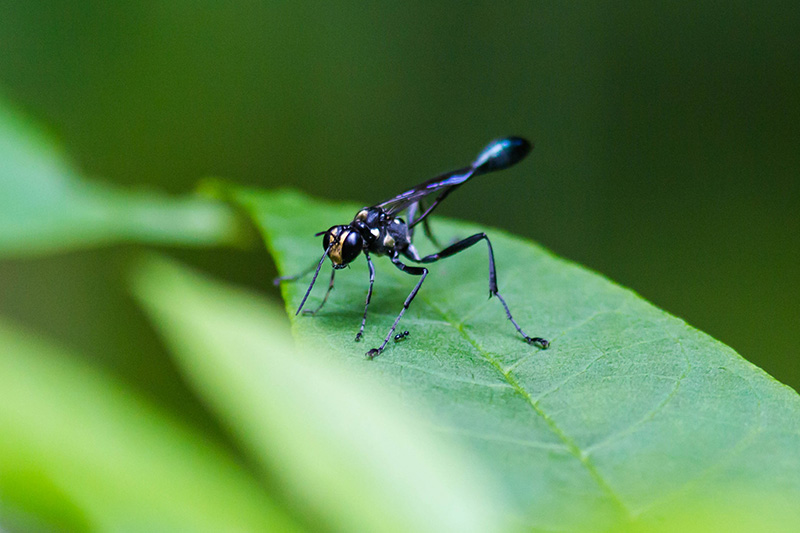
E. aureonotata looks superficially like the common blue mud-dauber. You’ve probably seen mud-dauber nests (they look like little mud balls, with holes where the adult wasps emerge), but those nests likely weren’t built by this species. They’re nest parasites, which means they steal the larvae of other daubers out of their nests and replace them with their own. They feed their young by sealing paralyzed spiders into the nest with mud, and they’re especially fond of black widows (free pest control for you!). They catch spiders via the sinister method of tapping on the web, which causes vibrations that make the spider think it’s trapped a meal…only to become one. Stone-cold.
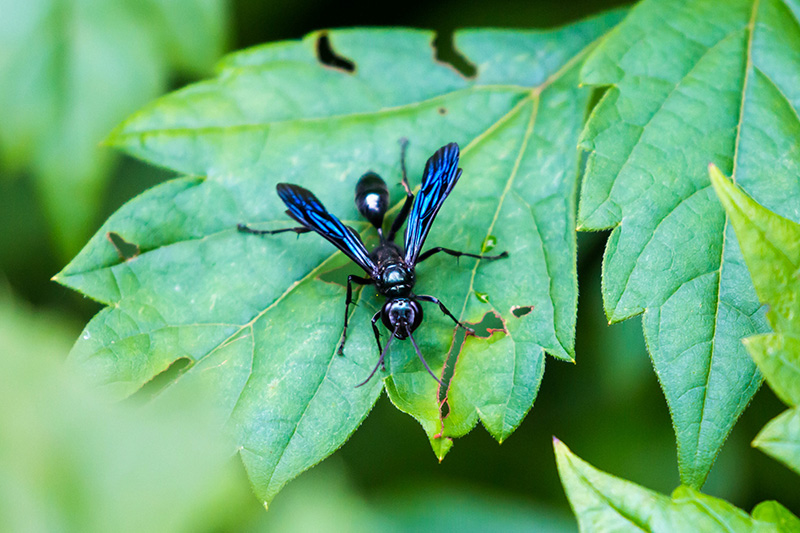
Another brilliant blue thread-waisted wasp is the steel-blue cricket hunter. You’ll often see this wasp on the ground, twitching violently, in search of crickets or grasshoppers. The female wasp digs a slender burrow in the ground, stuffs it with a cricket she’s paralyzed with her stinger, and lays a single egg onto that cricket. As the egg hatches, it eats its way through that cricket for a few days before pupating inside the burrow, from which it will emerge as an adult next summer. (The “few days” timetable is the reason these wasps paralyze their targets instead of killing them. It keeps the food fresh!)
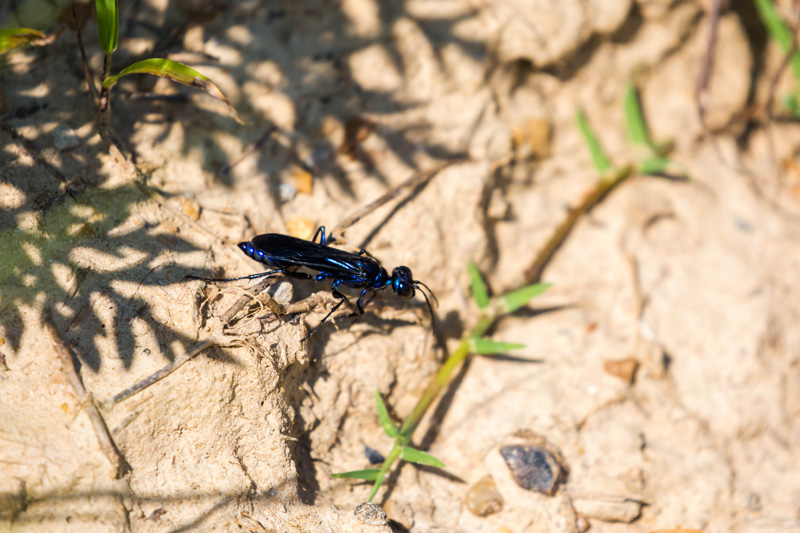
The brown-legged grass-carrying wasp is unusual for a thread-waisted wasp in that it nests above the ground. It often chooses hollow plant stems, or nests vacated by previous inhabitants. The grass that it carries serves as a lining for the cells in which it lays eggs, separating the larvae from each other in the nest.
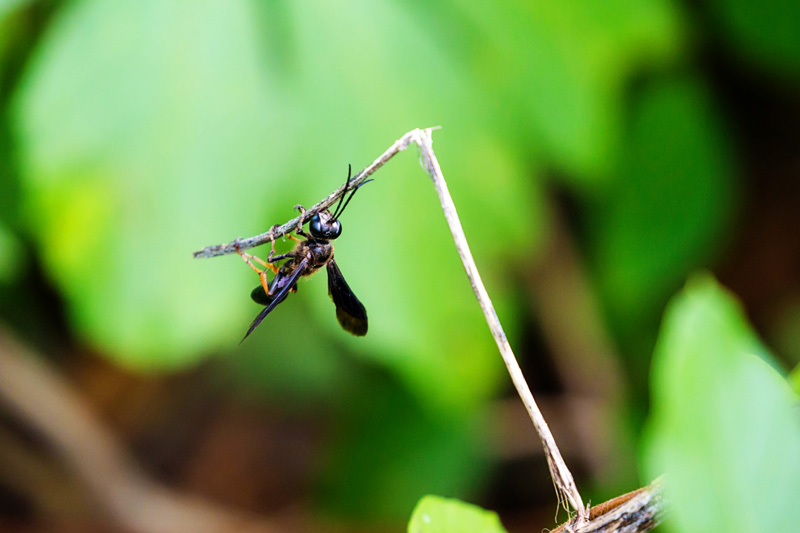
The majority of the thread-waisted wasps I’ve found in Overton Park are in the genus Sphex, which are known as digger wasps. Case in point: here’s a Sphex dorsalis female with a nest she’s excavated.
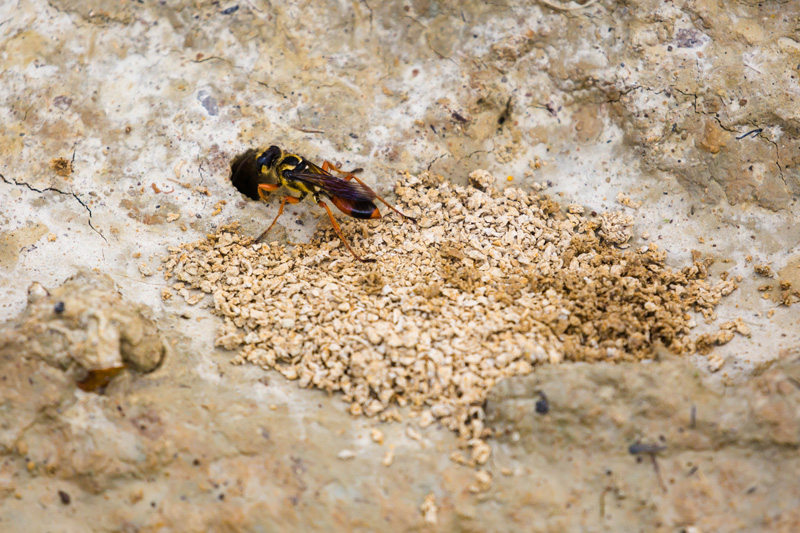
Some of you academic folks might be familiar with the term “sphexishness,” which is a word coined to describe a kind of mindless, mechanical behavior. The term was inspired by the below wasp, Sphex ichneumoneus, the great golden digger wasp. Her mode of provisioning her nest includes paralyzing an insect, laying it to the side of her nest, and then checking inside the nest before dragging in the insect. In experiments, if the prey was moved a few inches away, the wasp would locate the prey and repeat the nest-checking procedure before dragging it in. This locked-in process could happen dozens of times without the wasp ever just carrying the insect directly inside. The term “sphexishness” was thus used to describe a stubborn, repetitive behavior.
Humans are more complex than wasps, certainly, so maybe we can’t be sphexish in exactly the same way. But I know how I’ll be describing my own hard-to-break bad habits from now on.

On a less etymological note, one day I happened upon a Sphex dorsalis and a Sphex habenus, the golden-reined digger wasp, aggressively circling each other in a drainage ditch on the golf course. Eventually they settled down long enough for me to get a photo, which I immediately christened…”Battle of the Sphexes.” (Come for the philosophical concepts, stay for the terrible taxonomic puns!)
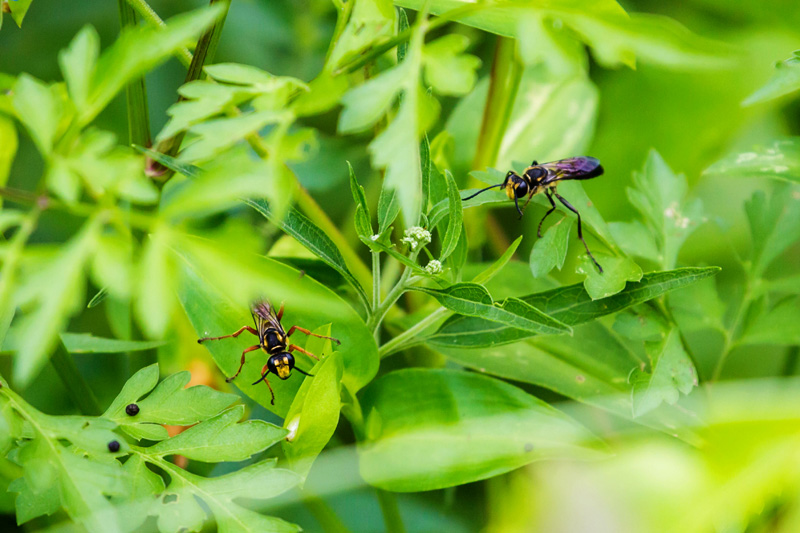
Finally, we arrive at a bit of a risqué conclusion. I was walking in Shelby Farms Park recently and was surrounded by nectaring Ammophila pictipennis wasps. It’s not at all unusual to see a mating pair resting on a flower, but this pair looked especially bulky. When I took a closer look, I saw it was actually three wasps. “Is that a frequent thing?” I wondered, gingerly typing in Google search terms that I hoped would only deliver photos of bugs…

I didn’t find much information on this phenomenon, but two males probably made a play for the same female at the same time, and the one who got there too late just hung around anyway. Perhaps he decided this was the easiest place to wait his turn, given that wasps mate with multiple partners. (Any actual entomologists are welcome to chime in and elaborate!)
Now that you’ve read my briefly scandalous tribute to thread-waisted wasps, I highly recommend this New York Times article about the kinds of wasps that often inspire fear. You may never see paper wasps the same way again after seeing their flight described as looking like they’re wearing pants!



